|
|
Haz hecho público que te gusta. Deshacer
Haz hecho público que te gusta. Deshacer
Búsquedas relacionadas con serket
|
|
|
|
|
Serket
From Wikipedia, the free encyclopedia
| Serket |

the Egyptian goddess Serket. She is often depicted as a woman with a scorpion gracing her crown. She holds the ankh, the symbol of life, in one hand and a staff, representing power, in the other.
|
| Name in hieroglyphs |
[1] |
| Symbol |
Scorpion |
| Parents |
Ra |
| Siblings |
presumably Hathor, Sekhmet, Bast |
Serket //, also known as Selket, Serqet or Selcis //, is the goddess of healing poisonous stings and bites in Egyptian mythology, originally the deification of the scorpion.[2]
Scorpion stings lead to paralysis and Serket's name describes this, as it means (she who) tightens the throat, however, Serket's name also can be read as meaning (she who) causes the throat to breathe, and so, as well as being seen as stinging the unrighteous, Serket was seen as one who could cure scorpion stings and the effects of other poisons such as snake bites.
In Ancient Egyptian art, Serket was shown as a scorpion (a symbol found on the earliest artifacts of the culture, such as the protodynastic period), or as a woman with a scorpion on her head. Although Serket does not appear to have had any temples, she had a sizable number of priests in many communities.
The most dangerous species of scorpion resides in North Africa, and its sting may kill, so Serket was considered a highly important goddess, and was sometimes considered by pharaohs to be their patron. Her close association with the early kings implies that she was their protector, two being referred to as the scorpion kings.
As the protector against poisons and snake bites, Serket often was said to protect the deities from Apep, the great snake-demon of evil, sometimes being depicted as the guard when Apep was captured.
As many of the venomous creatures of Egypt could prove fatal, Serket also was considered a protector of the dead, particularly being associated with poisons and fluids causing stiffening. She was thus said to be the protector of the tents of embalmers, and of the canopic jar associated with poison—the jar of the intestine—which was deified later as Qebehsenuf, one of the Four sons of Horus.
As the guard of one of the canopic jars and a protector, Serket gained a strong association with Aset (Isis), Nebet Het (Nephthys), and Neith who also performed similar functions. Eventually, later in Egyptian history that spanned thousands of years and whose pantheon evolved toward a merger of many deities, Serket began to be identified with Isis, sharing imagery and parentage, until finally, Serket became said to be merely an aspect of Isis, whose cult had become very dominant.
References[edit]
|
|
|
|
|
Serqet
 |
Serqet (Selket, Serket, Selqet, Selkit, Selkis) was a benevolent scorpion goddess. She was generally viewed as a protective goddess, but also had her darker side. Serqet was thought to have power over venomous snakes and scorpions, like Meretseger and Isis. It was thought that she could protect a person from venomous bites, and also that she could send snakes and scorpions to meet out punishment to those of whom she disapproved. She was originally worshiped in the Delta, but her popularity spread throughout the land and cult centres were established at Djeba (Edfu) and Per-Serqet (Pselkis, el Dakka). However, no temples specifically dedicated to her has been recovered.
|
According to some versions of the story, it is she who helps protect Isis and her infant son Horus when they are hiding from Set in the marshes of the delta. She is associated with the seven scorpions who act as a body guard for the mother and child and is sometimes named as the goddess who convinces Ra to stop the sun barque and help when Horus is poisoned by a magical snake sent by Set. Because of this story, she was thought to offer special protection to children and pregnant women from venomous animals.
|
She also protected Ra as he travelled though the underworld each night. She was said to watch over any dangerous twist in the path and was responsible for restraining the serpent Apep when he was imprisoned in the netherworld and protecting the sun god´s barqe from his attack. This protection was extended to everyone who made the difficult journey through the netherworld.
|
 |
In the tomb of Nefertari (wife of Ramsess II) the goddess welcomes the queen into the afterlife saying "(I am) Serqet, mistress of heaven and lady of all the gods. I have come before you, the King´s Great Wife, Mistress of the Two Lands, Lady of Upper and Lower Egypt, Nefertari, Beloved of Mut, Justified Before Osiris Who Resides in Abydos, and I have accorded you a place in the sacred land, so that you may appear gloriously in heaven like Ra."
 |
However, like the other goddesses known as the "Eye of Ra", she was She was thought to be either the mother or daughter of Ra. who was embodied in the scorching heat of the sun.
She was given the epithet, "Lady of the Beautiful Tent" and "Mistress of the Beautiful House", (referring to the embalmer's tent). She also protected Qebehsenuef (one of the four sons of Horus) who guarded the intestines of the deceased.
She was associated with the western cardinal point (the west was associated with death and rebirth). Yet, she was closely associated with the breath of life. Her enemies would have their breath literally taken away by the effect of a poisonous bite, but she also gave the justified dead the breath of life in the afterworld. In the Book of the Dead, she is associated with the teeth of the deceased. A longer version of her name (srq.t-Ht.w) is often translated as "She Who Lets Throats Breathe", or conversely "she who stiffens (paralyses) the throat".
According to the Pyramid Texts she was the mother of Nehebkau, the snake god who protected the pharaoh from snakebites. She was closely associated with Isis and her sister Nephthys because of her connection with magic and the underworld. In Edfu she was said to be the wife of Horus and the mother of Horakhty (Horus of the Horizon).
|
She often appeared with the ancient warrior goddess Neith. In the mortuary temple of Hatshepsut Neith and Serqet are present when Amen impregnates Hatshepsut's mother, Mutemwia. In another tale the two goddesses ensure that Amen and his wife get to enjoy some quality time in peace, and so she was also considered to be a goddess of marriage.
Serqet was often shown as a woman with a scorpion on her head, and occasionally as a scorpion with the head of a woman, though this was rare. She was sometimes shown wearing the headdress of Hathor ( a solar disk and cow horns) but it is thought that this was more to do with her association with Isis. From the Twenty First Dynasty, she was occasionally depicted with the head of a lioness and a protective crocodile at the back of her neck. However, the most famous image of Serqet is the golden figure that forms one of the four goddesses protecting Tutankhamun which was found in his tomb.
copyright J Hill 2010
|
|
|
|
|

ouroboros.softonic.com
OUROBOROS
700 × 503 - 48k - jpg |

ouroboros.softonic.com
Ouroboros sigue la estela
700 × 501 - 57k - jpg |

ouroborosartepostal.bl...
EL ESCARABAJO MEXICO CONVOCA A
1600 × 1054 - 721k - jpg |

ouroboros.softonic.com
OUROBOROS
700 × 501 - 52k - jpg |

ouroboros.softonic.com
OUROBOROS
125 × 70 - 8k - jpg |

ouroboros.softonic.com
OUROBOROS
125 × 70 - 8k - jpg |

ouroboros.softonic.com
OUROBOROS
125 × 70 - 9k - jpg |
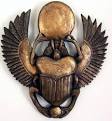
forum.top.igg.com
El escarabajo egipcio
334 × 360 - 37k - jpg |

ouroborosartepostal.bl...
Ouroboros - arte postal - mail
1600 × 1036 - 716k - jpg |

tuscriaturas.blogia.com
El Ouroboros 1 es una criatura
540 × 361 - 20k - jpg |

ouroborosartepostal.bl...
EN EL BLOG DEL ESCARABAJO,
640 × 960 - 83k - jpg |

ecoturismoesoterico.bl...
el "plomo" es nuestro
243 × 299 - 60k - jpg |

sanchezdrago.com
Caballero del Escarabajo
700 × 525 - 51k - jpg |

bcntattoo.com
El escarabajo ha encontrado la
210 × 210 - 25k - php |

guadalupeaguilera.blog...
Ouroboros y Tetractys
550 × 413 - 99k - jpg |

sanchezdrago.com
Caballero del Escarabajo.
525 × 700 - 59k - jpg |

pijamasurf.com
Y la famosa canción de The
590 × 603 - 516k - png |

ouroborosartepostal.bl...
Ouroboros - arte postal - mail
1600 × 1052 - 840k - jpg |

tatuajes123.com
Historia Interminable: Auryn
137 × 174 - 4k - jpg |

amimedamiedo.blogspot.com
al escarabajo Khepri en el
334 × 400 - 25k - jpg |
|
|
|
|
|
El ANKH:
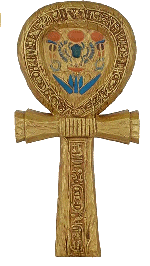 El ANKH o LA CRUZ ANSATA es el amuleto más antiguo de Egipto. El signo jeroglífico del Ankh significa: Vida o Vida eterna. Atañe , no solo al mundo material, sino también, de una manera más importante a la vida del más allá, la segunda vida, la vida del espíritu. El ANKH o LA CRUZ ANSATA es el amuleto más antiguo de Egipto. El signo jeroglífico del Ankh significa: Vida o Vida eterna. Atañe , no solo al mundo material, sino también, de una manera más importante a la vida del más allá, la segunda vida, la vida del espíritu.
El símbolo del Ankh combina los principios generativos del hombre y de la mujer en un solo diseño. El lazo o curva representa los órganos de la reproducción femenina y lo que resta lo masculino.
Su imagen es similar a la cruz cristiana; únicamente varía la parte superior, que presenta una forma ovalada a modo de argolla o asa. La argolla superior representa la entrada del agua que inundaba el valle del Nilo y producía la fertilidad. Era uno de los principales atributos de la diosa Isis, que fue quien consiguió devolver la vida a su esposo y hermano Osiris. Aunque, en realidad, la mayoría de los dioses, en su calidad de inmortales, la llevaban.
Son muy numerosos los grabados y esculturas en los que aparece un dios o diosa con la cruz en la mano, acercándosela a la nariz de algún otro dios o protegido. Con este gesto el portador de la cruz insuflaba aliento de vida al otro, quien a su vez, lo recibía a través de las ventanas de su nariz. A menudo se la representó en la mano de los faraones egipcios, en cuya coronación jugaba un importante papel.
Es la vida con mayúscula, la que no acaba con la muerte, la que resurge y continúa. Por eso, se aplicaba a la frente de los faraones, para que su visión de la eternidad prevaleciera durante todo su mandato por encima de cualquier contratiempo.
Por tanto, como amuleto, favorece la longevidad y la sabiduría de quien ha vivido muchas vidas. Portar un talismán con el Ankh significa solicitar fertilidad y abundancia. Pero también un paso más: ir en pos de la espiritualidad.
El IEB O CORAZÓN:
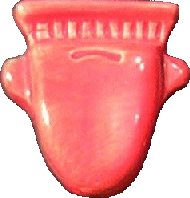 Los dioses esta satisfecho”(ieb-neteru-hotep). Para los antiguos egipcios el corazón era el lugar del pensamiento, de la emoción y de la propia vida. En el juicio ante Osiris, el corazón era pesado en contraposición a la pluma de la justicia y la verdad (ma´at); recitando los ensalmos “¡oh, mi corazón. no permanezcas como un testigo en mi contra. No me contradigas ante los jueces. No actúes contra mi ante los Dioses. No seas mi enemigo en presencia del guardián de la balanza Anubis.”, por lo que el amuleto ieb era de vital importancia para el paso a otro nivel de existencia. La palabra ieb aparece en los conceptos como “buen amigo” (ak-ieb) traduciéndose como “uno que ha entrado en el corazón”, “alegría” (au-ieb), y en las expresiones religiosas como “el corazón de los dioses esta satisfecho”(ieb-neteru-hotep). Los dioses esta satisfecho”(ieb-neteru-hotep). Para los antiguos egipcios el corazón era el lugar del pensamiento, de la emoción y de la propia vida. En el juicio ante Osiris, el corazón era pesado en contraposición a la pluma de la justicia y la verdad (ma´at); recitando los ensalmos “¡oh, mi corazón. no permanezcas como un testigo en mi contra. No me contradigas ante los jueces. No actúes contra mi ante los Dioses. No seas mi enemigo en presencia del guardián de la balanza Anubis.”, por lo que el amuleto ieb era de vital importancia para el paso a otro nivel de existencia. La palabra ieb aparece en los conceptos como “buen amigo” (ak-ieb) traduciéndose como “uno que ha entrado en el corazón”, “alegría” (au-ieb), y en las expresiones religiosas como “el corazón de los dioses esta satisfecho”(ieb-neteru-hotep).
Los amuletos-corazón son de cornalina, jaspe rojo, cerámica vitreada roja o pasta de color. Tanto la cornalina como el jaspe rojo simbolizan el dinamismo, el coraje necesario para enfrentarse a los enemigos invisibles. Se relacionan con la ira de las divinidades defendiendo sus lugares, cuya raíz debe ser el cielo y no las pasiones animales. Es la exaltación, hija del Cielo.
El TYET:
 El Tyet o el nudo de Isis es un amuleto simboliza la regeneración femenina; su color rojizo alude a “la sangre de Isis”. Puesto que la mujer otorga la vida, su papel dentro de la magia egipcia era fundamental; siendo la principal exponente la Diosa Isis, “la señora de la magia”. En ocasiones el tiet personifica también a las Diosas Nut, Hathor y Neftis , en donde el nudo constituye una especie de vestido, con la parte central y las piezas laterales formando un estilizado ceñidor. La asociación del tiet con lo femenino y del djed con lo masculino eran una forma de expresar la naturaleza dual de la vida, así como ser una representación simbólica de los Dioses Isis y Osiris, los padres del Dios Horus. El signo tyet también se utilizo como insignia de oficio para el mayordomo o “encargado” de palacio (jerepah). El Tyet o el nudo de Isis es un amuleto simboliza la regeneración femenina; su color rojizo alude a “la sangre de Isis”. Puesto que la mujer otorga la vida, su papel dentro de la magia egipcia era fundamental; siendo la principal exponente la Diosa Isis, “la señora de la magia”. En ocasiones el tiet personifica también a las Diosas Nut, Hathor y Neftis , en donde el nudo constituye una especie de vestido, con la parte central y las piezas laterales formando un estilizado ceñidor. La asociación del tiet con lo femenino y del djed con lo masculino eran una forma de expresar la naturaleza dual de la vida, así como ser una representación simbólica de los Dioses Isis y Osiris, los padres del Dios Horus. El signo tyet también se utilizo como insignia de oficio para el mayordomo o “encargado” de palacio (jerepah).
El nudo de la diosa Isis , también conocido como el símbolo de Tyet, era una representación estilizada de los genitales de la diosa . Casi cada mujer llevaba este amuleto para que se conceda toda la sabiduría de Isis y su conocimiento . Este amuleto sirve como un amuleto de la fertilidad. Casi siempre se hacía de piedra roja y contenía una piedra verde. Solía colocarse sobre la garganta o el pecho.
El URAEUS:
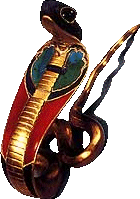 El uraeus, o ureus, es una representación de la diosa Uadyet. La imagen del uraeus constituyó el emblema protector preferente de muchos faraones, quienes eran los únicos que podían portarlo como atributo distintivo de la realeza. Uraeus fue el término que empleó Horapolón, un estudioso del Alto Egipto, a finales del siglo V a. C., en su tratado Hieroglyphica donde muestra una interpretación ideográfica de la escritura jeroglífica, y desde entonces se mantuvo dicho nombre. El uraeus, o ureus, es una representación de la diosa Uadyet. La imagen del uraeus constituyó el emblema protector preferente de muchos faraones, quienes eran los únicos que podían portarlo como atributo distintivo de la realeza. Uraeus fue el término que empleó Horapolón, un estudioso del Alto Egipto, a finales del siglo V a. C., en su tratado Hieroglyphica donde muestra una interpretación ideográfica de la escritura jeroglífica, y desde entonces se mantuvo dicho nombre.
El uraeus tenía forma de cobra y, algunas veces, portaba la corona Roja del Bajo Egipto y la corona Blanca del Alto Egipto. La diosa cobra Uadyet, solía figurar junto a la diosa buitre Nejbet, como representantes del Alto y Bajo Egipto.
Uadyet, originaria del delta del Nilo, simbolizaba al Bajo Egipto, diosa protectora del faraón, era una serpiente que actuaba como protección de dioses y faraones en la mitología del antiguo Egipto y se le atribuía la característica de ser muy poderosa. Encarnaba a las diosas solares.
Nejbet, representada como un buitre, era símbolo del Alto Egipto; deidad protectora del faraón en los nacimientos, la coronación, las fiestas de jubileo y en las batallas.
Uno de los títulos del faraón, el nombre de Nebty contiene el Uraeus. También aparece representado en la parte superior de muchos templos y formando parte de las coronas egipcias, como diadema sujetando el Nemes (tocado de los faraones), y en joyas o amuletos de faraones y dioses.
La cobra y las serpientes eran símbolos de resurrección y estaban asociadas a los mitos solares del viaje del Sol por el cielo y el inframundo, la Duat. Se las veneraba principalmente en Buto y al morir se depositaban en cajas de bronce o madera, grabadas con relieves de imágenes de serpientes, que algunas veces tenían cabeza humana tocada con la corona Doble y el uraeus.
EL PILAR DYED:
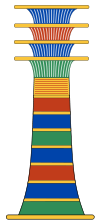 El Pilar Dyed, o Dyed, es un símbolo que pudo representar la columna vertebral del dios Osiris, un árbol, un poste conformado por gavillas de grano atadas, etc. Es uno de los símbolos más reproducido en la mitología egipcia, aunque se desconoce el objeto que representa realmente. El Pilar Dyed, o Dyed, es un símbolo que pudo representar la columna vertebral del dios Osiris, un árbol, un poste conformado por gavillas de grano atadas, etc. Es uno de los símbolos más reproducido en la mitología egipcia, aunque se desconoce el objeto que representa realmente.
El pilar dyed pudo ser un antiguo fetiche de la época prehistórica, relacionado con los ritos agrícolas, que perduró en la iconografía egipcia, siendo representado hasta el periodo de dominación romana.
De época Tinita se conocen pilares Dyed, hallados en Helwan. Posteriormente, durante el Imperio Antiguo, fue grabado en el recinto funerario del faraón Dyeser (Zoser) en Saqqara, en la necrópolis de Menfis, y parece indicar que era un símbolo asociado a otros conceptos, como soporte del cielo; o bien pudo ser asignado a otras divinidades, como Sokar y Ptah, pues estos dioses de Menfis aparecen representados portando este símbolo.
Durante el Imperio Nuevo, en el Papiro de Ani, está dibujado junto al signo de la vida, Anj, con unos brazos que portan un disco solar naciente, acompañado, a ambos lados, por su hermana Neftis y su esposa Isis, con varios monos que saludan y adoran al Sol. Es Osiris el representado con forma de Dyed.
Es posible que cuando Osiris, Ptah y Sokar fueron asociados, el pilar pasó a formar parte del simbolismo de Osiris cuando se difundió ampliamente su culto. El pilar Dyed también se encuentra en representado en los cetros uas de los dioses Thot y Jonsu.
“La erección del pilar Dyed” era una célebre ceremonia de origen menfita, posiblemente en honor al dios Ptah, que posteriormente se asoció con Osiris. Mediante la celebración de esta ceremonia se simbolizaba la estabilidad del reinado, la resurrección de Osiris, y la victoria de éste dios sobre Seth. Esta ceremonia constituía un modo de renovar, regenerar y revitalizar periódicamente las fuerzas del faraón para que pudiera seguir reinando sobre el trono de Egipto. Además, debía repetirse durante la fiesta Heb Sed. Se puede observar, entre otros lugares, en el templo de Sethy I en Abidos, el lugar de culto a Osiris.
El ojo de Horus ” el ojo que todo lo ve”:
 El ojo de Horus, es uno de los amuletos más conocidos del antiguo Egipto y del mundo musulmán actual. Como talismán simboliza la salud, la prosperidad, la indestructibilidad del cuerpo y la capacidad de renacer. El wedjat, un ojo en parte humano y en parte de halcón, es el ojo de Horus, dios de los cielos, y viene a significar «la unidad o totalidad restablecida». Estos amuletos les servían no solo contra las enfermedades sino también contra traiciones, conjuros y maldiciones enviados por los enemigos y mal de ojo. El ojo de Horus, es uno de los amuletos más conocidos del antiguo Egipto y del mundo musulmán actual. Como talismán simboliza la salud, la prosperidad, la indestructibilidad del cuerpo y la capacidad de renacer. El wedjat, un ojo en parte humano y en parte de halcón, es el ojo de Horus, dios de los cielos, y viene a significar «la unidad o totalidad restablecida». Estos amuletos les servían no solo contra las enfermedades sino también contra traiciones, conjuros y maldiciones enviados por los enemigos y mal de ojo.
Era uno de los más poderosos amuletos, que protegía especialmente la incisión practicada en la momia para extraer sus órganos. Al ojo se le representó, desde hace miles de años, con un círculo con un punto en el centro, el mismo símbolo que representa al Sol y, por lo tanto, representa el poder de lo eterno, que no cambia con el tiempo.
Propiedades del Lapislázuli para los Egipcios:
En Egipto el lapislázuli creían que curaba la melancolía y la fiebre.
A través de los siglos, sus propiedades más representativas han estado unidas al color azul, símbolo de pureza, salud, suerte y nobleza, por lo que los egipcios, lo utilizaron en aderezos y mascaras funerarias. El lapislázuli está considerado como gema de la iluminación espiritual, incidente más en el mundo interior que en el exterior, propicio al desarrollo del “ser” más que en el “hacer” o en el “tener” y la suerte que puede proporcionar revierte no sólo en beneficio propio si no en desprendimiento hacia los demás.
El escarabajo como amuleto:
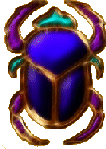 El escarabajo fue un amuleto de vida y poder, con forma de escarabajo pelotero (Scarabaeus sacer egipcio), que representaba al Sol naciente, y era símbolo de la resurrección en la mitología egipcia. En vida proporcionaba protección contra el mal, visible o invisible, dando diariamente fuerza y poder. En la muerte, quien lo portaba adquiría la posibilidad de resucitar y alcanzar la vida eterna. El escarabajo fue un amuleto de vida y poder, con forma de escarabajo pelotero (Scarabaeus sacer egipcio), que representaba al Sol naciente, y era símbolo de la resurrección en la mitología egipcia. En vida proporcionaba protección contra el mal, visible o invisible, dando diariamente fuerza y poder. En la muerte, quien lo portaba adquiría la posibilidad de resucitar y alcanzar la vida eterna.
El escarabajo estaba vinculado con el dios Jepri, forma de Ra como Sol naciente, y era el símbolo de la constante transformación de la existencia.
Varias especies de escarabajos peloteros, principalmente el Scarabaeus sacer, gozaron de un estatus sagrado entre los egipcios.
Su nombre jeroglífico se translitera como o xpr, y se traduce como “convertir” o “transformar”. El término derivado xprw se traduce como “forma”, “transformación”, “suceso”, “modo de ser” o “el autocreado”, dependiendo del contexto. Puede tener significado existencial, ficticio u ontológico.
El escarabajo fue asociado a Jepri, el autocreado, el dios asociado al Sol naciente. Antiguamente se creía que el escarabajo era solamente de género masculino y que se reproducía depositando el semen en una bola de estiércol. La supuesta auto-reproducción del escarabajo lo asemeja a Jepri, que se creó así mismo de la nada. Por otra parte, la bola de estiércol rodada por el escarabajo pelotero se asemeja al Sol. Plutarco escribió:
Los egipcios creyeron que Jepri renovaba el Sol cada día tras su desaparición en el horizonte, llevándole a través del mundo subterráneo, Duat, después del ocaso para renovarle otra vez al día siguiente. Algunas tumbas reales del Imperio Nuevo exhiben una imagen triple del dios del Sol, con el escarabajo como símbolo del Sol de la mañana. El techo astronómico en la tumba de Ramsés VI relata la “muerte” cada noche y el “renacimiento” del Sol como siendo tragado por Nut, diosa del cielo, y reapareciendo de su matriz como Jepri. La imagen del escarabajo asociado a ideas de transformación, renovación y resurrección, es ubicua en el arte religioso y funerario egipcio antiguo.

Los escarabajos fueron tallados en variados materiales: esteatita, basalto, granito y en piedras preciosas como lapislázuli, amatista, cornalina, e incluso en metales como el oro. Las excavaciones arqueológicas en Egipto han sacado a la luz imágenes de escarabeos en hueso, marfil, piedra, fayenza egipcia y metales preciosos, fechados desde la sexta dinastía hasta el período romano.
Son generalmente pequeños y están agujereados para permitir engarzarlos en un collar, y en la base llevan una breve inscripción o un cartucho egipcio. En general se usaban como amuletos, y en su reverso llevaban figuras o textos. Algunos tenían escrito el nombre de su propietario y se han utilizaban como sellos, un uso extendido en las ánforas con vino, mercancía de lujo. Los faraones encargaron a veces la fabricación de ejemplares más grandes con largas inscripciones, como el escarabajo conmemorativo de la boda de la reina Tiy. Grandes esculturas de escarabajos se pueden encontrar en los templos de Tebas, en el Serapeum de Alejandría y en otros lugares de Egipto.
El escarabajo tenía una gran importancia en el culto funerario egipcio. Generalmente era tallado en piedra verde y colocado en el pecho de los difuntos, para proteger el corazón y sustituirle durante la momificación. El propósito del “escarabajo del corazón” era asegurarse de que el corazón no testimoniaría contra el difunto en el juicio de los muertos. Otra posibilidad es la sugeridas por las palabras de transformación de los Textos de los Sarcófagos, que afirman que el alma de los difuntos puede transformarse (xpr) en un humano, un dios, o un pájaro y reaparecer en el mundo de los vivos.
Quizás el ejemplo más famoso de tales “escarabajos del corazón” es el de color verde amarillento encontrado entre las provisiones de la tumba de Tutankamón, tallado en un gran trozo de mineral cristalino del desierto libio.
Hechos en su mayoría de esteatita vidriada, medían entre 4,7 y 11 cm, con un texto en su parte inferior. Eran utilizados como sellos de representación del rey, su familia, y algunos dignatarios, durante el segundo periodo intermedio de Egipto (hicsos). Son una de las principales fuentes de información de la dinastía XIV y la XV. Se han encontrado, además de en Egipto, en Canaán y Kush.
Fue muy usado en la dinastía XVIII, dándole Thutmose III el uso de sello real. Amenhotep III los utilizó profusamente, como forma de propagar por sus dominios las noticias relacionadas con él o con la familia real. Los más numerosos hablan de leones muertos con sus propias flechas, y de cacerías de toros salvajes. Otros ejemplares hablan de su boda con Tiy, de la construcción de un lago artificial en el palacio de Malkata o de la llegada de la princesa mitania Kilughepa con otras 317 mujeres al harén real. Estos escarabajos propagandísticos eran de un tamaño mayor, y se distribuían entre los cortesanos, altos funcionarios o bien se enviaban como obsequio a los reyes de países aliados.
El escarabajo sigue siendo un artículo popular gracias al interés y fascinación moderna hacia el arte y las creencias del Antiguo Egipto. Escarabajos en piedras semipreciosas o en cerámica esmaltada se pueden comprar en la mayoría de las tiendas, mientras que en el templo de Karnak ha tenido que ser protegido un antiguo gran escarabajo, representación de Jepri, para desalentar a los visitantes de la práctica supersticiosa consistente en frotar la basa de la estatua para conseguir suerte; ahora muchos se limitan a dar tres vueltas alrededor de él.
El escorpión como amuleto:
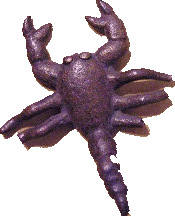 Se llevaba como protección contra las picaduras o mordeduras de insectos y serpientes venenosas . se confeccionaba generalmente en malaquita o turmalina verde, como colgante o anillo. Se lo asociaba a los signos de Virgo y Escorpio. Se llevaba como protección contra las picaduras o mordeduras de insectos y serpientes venenosas . se confeccionaba generalmente en malaquita o turmalina verde, como colgante o anillo. Se lo asociaba a los signos de Virgo y Escorpio.
Protección contra la envidia las traiciones, que al que lo lleve no le afecte o se diera cuenta de antemano.
http://esoterismo-egipcio.elreinomagico.net/amuletos.htm
|
|
|
|
|
Susana Alegre García 01 de Noviembre de 2008
Última actualización el 12 de Noviembre de 2008
Época: Dinastía XVIII, reinado del faraón Tutankhamón (1334-1325 a.C.)
Dimensiones: Altura: 9 cm. Ancho: 10'5 cm.
Material: oro, lapislázuli, cornalina, turquesa, feldespato…
Lugar de conservación: Museo de El Cairo
Lugar de localización: tumba de Tutankhamón en el Valle de los Reyes (KV 62)[1]

Foto 1. Pectoral con escarabajo alado de Tutankhamón. Foto en Foto en T.G. HENRY JAMES, Tutankamón, Barcelona, 2001, p. 231.
Entre los magníficos hallazgos que iba a deparar la exploración de la tumba de Tutankhamón, una de las más sugestivas sorpresas se localizó en el interior de un cofre situado en la cámara del Tesoro (Fig. 2 )[2]. Allí, removidas por la búsqueda de antiguos saqueadores (Fig. 3), Howard Carter encontró un grupo de joyas entre las que se encontraba un pectoral que representa un escarabajo alado[3]. Se trata, sin duda, de una de las representaciones más espectaculares y atractivas de uno de los temas más reiterados en la iconografía egipcia(Fig. 1).
El insecto, realizado en lapislázuli, despliega unas vistosas alas que se curvan y culminan con la figura de un disco solar. El diseño se consigue gracias a las incrustaciones engastadas con el procedimiento del cloisonné, una técnica de gran tradición en el Egipto faraónico. En la parte del reverso es visible una única y gran anilla de sustentación, que permitía que la joya se colgara posiblemente de un cordón o cadena. El lecho de oro también se presenta sucintamente ornamentado, destacándose mediante cincelado las formas del escarabajo, de sus alas, etc. (Fig. 4). Lo cierto es que el trabajo resulta un tanto burdo y son apreciables desalineaciones e imprecisiones[4].
En lo que respecta a los recursos plásticos utilizados en el pectoral (Fig. 1), hay que destacar el contraste cromático conseguido en las alas, así como el diseño que hace que se curven y extiendan hacia el disco solar. Se trata de un composición simétrica, con un cuidado efecto ascendente y que consigue orientar la atención hacia el disco solar. También se puede observar que en el diseño de las alas se dejó una zona sin incrustaciones, lo que proporciona una superficie algo extensa de oro a cada lado de las patas delanteras del escarabajo. Así se enfatiza la presencia de estas patas, impidiendo que pudieran quedar diluidas entre el colorido y abigarramiento de las alas, donde el color azul, el mismo que el de las patas del animal, es dominante.

Foto 2. Cofres de la sala del Tesoro. En el interior del primer cofre mostrado en esta foto, con remates ornamentales claros, fue localizado el pectoral con escarabajo de Tutankhamón junto a otras magníficas joyas. Foto en http://www.ashmolean.org/gri/carter/267-p1091.html
Las otras dos patas del animal, de relevancia secundaria, prácticamente se confunden con los tonos azules imperantes. También llama la atención que el animal tenga únicamente cuatro patas, cuando en realidad el escarabajo pelotero dispone de seis. Parece que las extremidades centrales se sacrificaron para no interferir en el diseño y conseguir un resultado mucho más armónico.
El disco solar, de dimensiones destacables, atrae la atención. El color de la cornalina ayuda a realzar su presencia, ya que en el resto de la joya imperan los tonos azules y verdosos, relegando el rojo únicamente
a pequeños detalles que sirven para otorgar ritmo y equilibro a la composición. Además, el disco se hace especialmente llamativo al situarse sobre un eje de simetría y gracias al diseño de las alas. Unas alas que consiguen que el conjunto del pectoral adquiera una forma redondeada, reiterando la alusión al disco y potenciando aún más el concepto solar implícito a la simbología de la joya. A ello sumar que para subrayar aún más la imagen del sol se realizó un ribeteado bastante ancho en el entorno de la incrustación, marcando un perfil de oro en su entorno que no aparece rodeando ningún otro elemento del pectoral.

Foto 3. Interior del cofre de la sala del Tesoro. Estado algo revuelto del interior del cofre donde fue localizado el pectoral del escarabajo de Tutankhamón. Foto en http://www.ashmolean.org/gri/carter/267-p1168.html
El escarabajo pelotero es común en Egipto, de modo que también en la antigüedad resultaba habitual la observación de los esfuerzos de dichos animales arrastrando y haciendo girar pelotas de estiércol. En esta imagen los egipcios encontraron una metáfora sencilla y efectiva, que permitía vincular el animal y el movimiento del astro solar a través del firmamento. Es decir, el dios escarabajo encarnaba la poderosa fuerza que consigue que el sol se eleve cada mañana en el horizonte y se desplace inexorablemente hacia el oeste.
Pero, además, hay que tener en cuenta que el escarabajo esconde bajo el subsuelo la bola de estiércol, colocándola en una especie de cámara en la que también se entierra y muere. Antes, no obstante, habrá puesto su huevo en el interior de la pelota que servirá de alimento a la larva y que permitirá su inicial desarrollo. Poco después, en el lugar del enterramiento, un nuevo escarabajo recién nacido emerge a la superficie. De modo que de alguna manera es como si un escarabajo viejo y cansado consiguiera renovarse para emprender una nueva existencia. Lo cierto es que no es de extrañar que los antiguos egipcios consideraran que el coleóptero goza de la capacidad de renacimiento y autogeneración, y que lo divinizaran dándole el nombre de Jepri "el que viene a la existencia" o "el que viene a ser".

Foto 4. Reverso del pectoral del escarabajo de Tutankhamón. Foto en H. STIERLIN, L'or des pharaons, París, 1993, p. 57.
Por sus implicaciones Jepri era fundamental en el contexto cosmogónico y la mitología le atribuía el poder de mover la gigantesca bola que ilumina el conjunto de la creación, convirtiéndose en motor de toda existencia. Una existencia que además es capaz de regenerar y de perpetuar, por lo que el escarabajo se vinculó estrechamente con las creencias de ultratumba y con la propiciación de la eternidad. Ciertamente el periplo vital del insecto implicaba un símil o referente en lo que respecta a la culminación de las expectativas funerarias: enterrarse para lograr la eternidad con energía renovada, emergiendo desde la arena del desierto hacia una nueva vida.
El escarabajo pelotero es una de las imágenes más tradicionales de la iconografía egipcia, siendo uno de los símbolos más habituales. Su representación se convirtió en un amuleto muy popular, al que se otorgaban capacidades protectoras y propiciadoras, y del que se han localizado innumerables ejemplos. Incluso sobre las momias, en la zona del pecho, frecuentemente se colocó un tipo de amuleto denominado "escarabajo de corazón", asimilando este poderoso motor de la existencia con el órgano motor del cuerpo humano y, según la creencia egipcia, también sede del pensamiento y la conciencia[5].

Foto 5. Colgante con escarabajo de Tutankhamón. Esta joya tiene el mismo diseño que el pectoral con escarabajo alado (Fig. 1), aunque se trata de una pieza más pequeña, en la que se ha eliminado el closionné en las zonas de las alas y se ha reducido la presencia de materiales preciosos. Foto en C. ALDRED, Jewels of the Pharaohs. Egyptian jewelry of the Dynastic Period, Londres, 1978.
|
|

Foto 6. Pectoral de Tutankhamón. Esta pieza fue localizada sobre la momia del monarca, junto con un conjunto magnífico de joyas. El escarabajo alado y el nombre del monarca vuelven a ser aquí el centro de la composición, donde también encuentra relevancia la simbología lunar. Foto en T.G. HENRY JA MES, Tutankamón, Barcelona, 2001, p. 218.
|
Dada sus profundas implicaciones no es sorprendente que la imagen del escarabajo pelotero se representara repetidamente en el ámbito de la tumba de Tutankhamón. Sin embargo, el escarabajo de este pectoral tiene unas peculiaridades que lo hacen todavía más rico a nivel referencial: la parte inferior de la joya se cierra con la forma del signo jeroglífico neb- y con tres pequeñas franjas verticales de color rojo que en escritura aluden al plural[6]. Estos elementos, conjuntamente con el escarabajo y el disco solar, integran el cartucho Nebjeperure, y con tres pequeñas franjas verticales de color rojo que en escritura aluden al plural[6]. Estos elementos, conjuntamente con el escarabajo y el disco solar, integran el cartucho Nebjeperure,  . Es decir, el pectoral, de manera ricamente plástica, escribe el Nombre de Trono del monarca. Este juego criptográfico, que fusiona el nombre del rey con la figura del escarabajo sosteniendo entre sus patas el disco del sol, es un recurso habitual entre las joyas de Tutankhamón (Fig. 5 y 6) y está presente en muchos objetos del ajuar localizado en su tumba (Figs. 7 y 8). . Es decir, el pectoral, de manera ricamente plástica, escribe el Nombre de Trono del monarca. Este juego criptográfico, que fusiona el nombre del rey con la figura del escarabajo sosteniendo entre sus patas el disco del sol, es un recurso habitual entre las joyas de Tutankhamón (Fig. 5 y 6) y está presente en muchos objetos del ajuar localizado en su tumba (Figs. 7 y 8).

Foto. 7. Tapa de caja de espejo de Tutankhamón. Foto en T.G. HENRY JAMES, Tutankamón, Barcelona, 2001, p. 197.
En el antiguo Egipto el nombre era considerado un componente fundamental en la identidad y se consideraba directamente asociado a la esencia de los individuos. En el caso de los reyes y de los dioses, los nombres alcanzaba una dimensión especialmente relevante y se les atribuían poderes excepcionales. De ahí que representar del escarabajo dando vueltas al disco solar e integrando a la vez los jeroglíficos que escriben el cartucho del rey, sea una imagen con la capacidad de alcanzar una gran significación. De hecho, trasformar los signos aislados que integran el nombre del faraón y convertirlos en una narrativa mitológica, presentaban al faraón de manera indiferenciable de la divinidad: la esencia del escarabajo divino y la del monarca se fusionan, sus naturalezas se confunden. La magia de la imagen y del jeroglífico convierten a Tutankhamón y Jepri en un único ser.

Foto 8. Detalles de una caja de cosméticos de Tutankhamón. Foto en Foto en H. STIERLIN, L'or des pharaons, París, 1993, p. 50.
Escribir el nombre de un individuo con materiales preciosos puede que sea un acto de ostentación[7], pero en este pectoral la vanagloria va más allá y se vincula con motivaciones de legitimación de la monarquía. En el marco de las estrategias de divinización, en las que se apoyó durante milenios la autoridad de los faraones, el pectoral permitía identificar al monarca con el poder revitalizador y todopoderoso del astro solar ente las patas del escarabajo. Quien se presentara ante Tutankhamón, cuando éste portara la joya, tendría la visión de un monarca rodeado de fasto sobre cuyo pecho palpitaba el motor que da vida al conjunto del cosmos.
[1] J. CARTER y A.C. MACE, The Tomb of Tut.ankh.amen, 3 vols., Londres, 1923-1933.
[2] Pieza nº 267 del inventario.
[3] Pieza nº267a del inventario.
[4] Aún tratándose de una joya realizada con los más preciosos materiales, algunos de sus rasgos hacen pensar en una cierta precipitación. Parece que el objetivo de quienes crearon esta joya se centraba más en alcanzar un resultado efectista y ostentoso, que en conseguir generar una obra perfecta y detallista. No obstante, lo cierto es que el resultado final consigue ser armonioso y elegante, convirtiendo a esta joya en una realización espectacular. Puede que el pectoral adolezca de la meticulosidad, por ejemplo, perceptible en ciertas joyas del Imperio Medio, pero también es obvio que los joyeros de Tutankhamón se movieron por otros retos y otros objetivos.
[5] El "escarabajo de corazón" debía proteger al difunto durante el juicio ante el tribunal de Osiris, el trance más complejo al que debía enfrentarse en su camino hacia el Más Allá. Para intensificar su eficacia mágica y propiciar que el propio corazón no pudiera realizar declaraciones que delataran negativamente al difunto, sobre el "escarabajo de corazón" se realizaba la inscripción del Capítulo 30 del Libro de los Muertos.
[6] En lo que respecta a las líneas verticales de cornalina que indican el plural, llama la atención que la central quede levemente desplazada. Ello puede tener que ver con el objetivo de no establecer un eje de simetría clara en la parte baja de la joya, cosa que habría podido desequilibrar un poco la llamada de atención que el conjunto del diseño orienta hacia la parte superior. También la presencia perfectamente alineada podría darle una entidad protagonista a la línea que no era la deseada y, a la vez, en esa posición podría desfigurar el perfil bajo del escarabajo, animal que sí es protagonista central. Sea como sea, lo cierto es que difícilmente puede tratarse de un defecto en la confección del pectoral, parece un efecto buscado ya que otras joyas de Tutankhamón, que tienen también estas tres líneas bajo el escarabajo, lucen la idéntica y curiosa desalineación (ver por ejemplo Fig. 5 y 6)
[7] El oro, las piedras preciosas, etc. gozaron en Egipto también de un gran simbolismo e incluso las distintas partes del cuerpo de los propios dioses se identificó con estos materiales preciosos. De modo que el mero hecho de escribir el nombre de un monarca con estos materiales es algo que integra una gran carga simbólica.
|
|
|
|
|
CARTA A UN CIENTÍFICO Time Temple letterFrom a letter to a scientist: "The conclusion should be made upon a probability, that it may be just coincidental, that these 14 lines are forming a very accurate model of the inner planetary system, showing also a precise time position, that coincidentally matches (relative to the end of Mayan Calendar) the beginning of the final 1260 days time period, mentioned both in the Old and New Testament (surely one of the most remarkable and disputed episodes in the Book), a time period, which allows (and was supposedly measured for) to show in a relatively short period of time, when, and what the End is all about - the mystery of death and the origin of life. After the probability is calculated, and if the figure shows that all what was presented is most likely just coincidental, then there would be no need to draw any conclusions. Yet if the probability figure shows, that it is most likely not a coincidence (if the figure is close to zero), then 12 21 '12 should be taken very seriously, and it becomes also more clear why these structures were built, and why so massive.
 |
Click para ampliar |
 As you probably know, at the end of 12th century, the son of Saladin, Aziz, led a muslim army "against the pyramids". The idea was to demolish the Giza complex completely, in order to show the superiority of Islam. They started with demolishing the smallest, the third pyramid. After about eight month of hard labour they realized how much time and money it would take to demolish all three pyramids. The minor damage made to the third pyramid is still visible. The birth of all civilizations ca 5000 years ago (now also called Great Divide), has been marked by many temple-structures, simultaneously emerging in different continents. These structures have proved to be carrying a certain information about the beginning, the development and also the end of the current era, while at the same time they have been clearly enhancing the growth of reasoning throughout the era (despite all obstacles, stupidity and controversy involved), through study and arts. There is a simple rule: to define the end of a circle, the beginning must be defined first. The current era began with the pyramids." Thoth's Time Temple - Giza Alignment Code Time-Shift TIME-SHIFT CODE EN ESTE VIDEO se muestra una interesante hipótesis, a partir de la cuál el complejo de gizeh replica la posición de los planetas interiores (marte venus mercurio y la tierra), el 9/julio/2009 - 3 años y medio previos al 21/Diciembre/2012 - 1260 dias antesLa hipótesis es discutible (aunque recomiendo el video y la página encarecidamente), partiendo de un alineamiento geométrico en el que el sol (posición central) tenga un tamaño menor......... siendo RA, lo que significaba para los egipcios. Aunque por otra parte podríamos considerar que las piramides (como así posiblemente sea), no fueron construidas por los egipcios, sino tomadas como legado de una civiliación anterior. Entonces el monumento es un "legado del tiempo" y ese detalle sobre el tamaño del sol quedaría en algo sin importancia.
 |
Click para ampliar |
 El número 1260 días, aparece en le antigüo y nuevo testamento "Revelation 11:11. The verse includes the words, "three and a half days." At one point, I re-read some dreams I had received, and two of them made a connection. In one of them a voice said, "The children were born in the sign of 42." In the other dream, I saw "Trinity 11:2." I looked up Revelation 11:2, and found that it speaks of the holy city being trampled over for 42 months. I then realized 42 months is is 3 1/2 years, perhaps connecting with the 3 1/2 days in Rev. 11:11. I then read the next verse, Rev. 11:3, which speaks of 1260 days. This was not quite 3 1/2 years, but dividing 1260 by 3.5 gives 360. It's like 3 1/2 times around a circle, again matching the 3 1/2 in the other verses. At the time, I did not know that the Hebrew calendar had 30-day months, but I now see that 1260 days is another way of indicating 3 1/2 years" REVELACIÓN 11:11 THE CODE OF CARL MUNCK, AND ANCIENT GEMATRIAN NUMBERS - PART ONECarl Munck CODE "¿Quién de ustedes que sea padre, si su hijo le pide[f] un pescado, le dará en cambio una serpiente? 12 ¿O si le pide un huevo, le dará un escorpión? 13 Pues si ustedes, aun siendo malos, saben dar cosas buenas a sus hijos, ¡cuánto más el Padre celestial dará el Espíritu Santo a quienes se lo pidan!" (Lucas 11:11) -Lucas - Great Cross - Heavens comes to Earth-  <****** width="640" height="360" src="http://www.youtube.com/embed/Nms_2A2dJUI?feature=player_detailpage" frameborder="0" allowfullscreen> "Two infinite power ballons. One -the plus- connected to the other -the minus- through the very center - the Zero  (Absolute ZERO point) TWIN TOWERS - JACHIN & BOAZ - Collapses  ZERO GROUND ERA -BLESSING [IMG]http://gothamist.com/***********/jen/2008_04_popegz7.jpg[/IMG] The Time Temple ¿Porqué (a día de hoy lo sabemos) el estado actuál de nuestro universo muestra que el 96% de la materia es oscura? ¿Cómo es que desde el orígen de todo (big ban - singularidad) hace 13 billones de años ha pasado ese enorme porcentaje de ser luz visible a luz no visible? A dónde ha ido? Desde entonces cuántos ciclos de luz-oscuridad ha habido y cuál es su duración?Sabemos que los agujeros negros se tragan la luz. Si nuestro Universo es dual, debe de haber "otro lado del espejo" dónde el 96% de materia sea visible y sólo el 4% antimateria...... Quizás desde luego sea un signo de un ciclo (13-baktun) que termina
 |
Click para ampliar |
Última edición por Dante2010; 02-sep-2012 a las 22:46
|
|
|
|
Es probable, los 60 grados del campo magnetico son un hecho confirmado por el Voyager, y tambien deberiamos entrar en la era de Acuario si es que ya no entramos, el codigo de la rueda de Ezequiel, por lo tanto si no es este año calculo estaremos muy proximos.
 |
Click para ampliar |
 La lapislazuli se encuentra en forma de rombo dodecahedro, casualmente es la piedra utilizada simbolicamente por Inana - Ishtar para bajar al inframundo. |
|
|
|
 |
Click para ampliar |
 Si gracias, Recordemos que el escarabajo equivale al signo de Cancer o sea el cangrejo
 |
Click para ampliar |
|
|
|
|
|
|
|
|
Busqueda para estiercol
1. Éxodo 29:14: Pero la carne del becerro, y su piel y su estiércol, los quemarás a fuego fuera del campamento; es ofrenda por el pecado.
2. Levítico 4:11: Y la piel del becerro, y toda su carne, con su cabeza, sus piernas, sus intestinos y su estiércol,
3. Levítico 8:17: Mas el becerro, su piel, su carne y su estiércol, lo quemó al fuego fuera del campamento, como Jehová lo había mandado a Moisés.
4. Levítico 16:27: Y sacarán fuera del campamento el becerro y el macho cabrío inmolados por el pecado, cuya sangre fue llevada al santuario para hacer la expiación; y quemarán en el fuego su piel, su carne y su estiércol.
5. Número 19:5: y hará quemar la vaca ante sus ojos; su cuero y su carne y su sangre, con su estiércol, hará quemar.
6. Jueces 3:22: de tal manera que la empuñadura entró también tras la hoja, y la gordura cubrió la hoja, porque no sacó el puñal de su vientre; y salió el estiércol.
7. 1 Reyes 14:10: por tanto, he aquí que yo traigo mal sobre la casa de Jeroboam, y destruiré de Jeroboam todo varón, así el siervo como el libre en Israel; y barreré la posteridad de la casa de Jeroboam como se barre el estiércol, hasta que sea acabada.
8. 2 Reyes 6:25: Y hubo gran hambre en Samaria, a consecuencia de aquel sitio; tanto que la cabeza de un asno se vendía por ochenta piezas de plata, y la cuarta parte de un cab de estiércol de palomas por cinco piezas de plata.
9. 2 Reyes 9:37: y el cuerpo de Jezabel será como estiércol sobre la faz de la tierra en la heredad de Jezreel, de manera que nadie pueda decir: Esta es Jezabel.
10. 2 Reyes 18:27: Y el Rabsaces les dijo: ¿Me ha enviado mi señor para decir estas palabras a ti y a tu señor, y no a los hombres que están sobre el muro, expuestos a comer su propio estiércol y beber su propia orina con vosotros?
11. Job 20:7: Como su estiércol, perecerá para siempre; Los que le hubieren visto dirán: ¿Qué hay de él?
12. Salmos 83:10: Que perecieron en Endor, Fueron hechos como estiércol para la tierra.
13. Isaías 36:12: Y dijo el Rabsaces: ¿Acaso me envió mi señor a que dijese estas palabras a ti y a tu señor, y no a los hombres que están sobre el muro, expuestos a comer su estiércol y beber su orina con vosotros?
14. Jeremías 8:2: y los esparcirán al sol y a la luna y a todo el ejército del cielo, a quienes amaron y a quienes sirvieron, en pos de quienes anduvieron, a quienes preguntaron, y ante quienes se postraron. No serán recogidos ni enterrados; serán como estiércol sobre la faz de la tierra.
15. Jeremías 9:22: Habla: Así ha dicho Jehová: Los cuerpos de los hombres muertos caerán como estiércol sobre la faz del campo, y como manojo tras el segador, que no hay quien lo recoja.
16. Jeremías 16:4: De dolorosas enfermedades morirán; no serán plañidos ni enterrados; serán como estiércol sobre la faz de la tierra; con espada y con hambre serán consumidos, y sus cuerpos servirán de comida a las aves del cielo y a las bestias de la tierra.
17. Jeremías 25:33: Y yacerán los muertos de Jehová en aquel día desde un extremo de la tierra hasta el otro; no se endecharán ni se recogerán ni serán enterrados; como estiércol quedarán sobre la faz de la tierra.
18. Ezequiel 4:15: Y me respondió: He aquí te permito usar estiércol de bueyes en lugar de excremento humano para cocer tu pan.
19. Nahum 3:6: Y echaré sobre ti inmundicias, y te afrentaré, y te pondré como estiércol.
20. Sofonías 1:17: Y atribularé a los hombres, y andarán como ciegos, porque pecaron contra Jehová; y la sangre de ellos será derramada como polvo, y su carne como estiércol.
21. Malaquías 2:3: He aquí, yo os dañaré la sementera, y os echaré al rostro el estiércol, el estiércol de vuestros animales sacrificados, y seréis arrojados juntamente con él.
ESTIERCOL / ESTHER-COLON / MERCURIO-ORION ISHTAR GATE (AGUJERO DE GUSANO)
|
|
|
|
|
|
 Gods and Goddesses Gods and Goddesses
Hathor

Key Facts
| Other names |
Hah-Thor |
| Year of origin |
2700 BCE |
| Location |
|
| Parent(s) |
|
| Partner(s) |
|
| Children |
|
| Aspect(s) |
|
| Major Centre(s) |
|
| Period of worship |
|
Background
Hathor (Pronounced Hah-Thor) (Egyptian for house of Horus) was originally a personification of the Milky Way, which was seen as the milk that flowed from the udders of a heavenly cow. Hathor was an ancient goddess, and was worshipped as a cow-deity from at least 2700 BC, during the second dynasty.
Her worship by the Egyptians goes back earlier however, possibly, even by the Scorpion King who ruled during the Protodynastic Period before the dynasties began. His name, Serqet, may refer to the goddess Serket.
Hathor is referred to as She with Two Faces, which is symbolic both for her ability to be cruel to humanity as well as kind and hence her ability to change shape from a woman into a bull or a serpent.
It was said that, with her motherly character, Hathor greeted the souls of the dead in Duat, and proffered them with refreshments of food and drink. She also was described sometimes as mistress of the acropolis.
Hathor also became associated with the menat, the turquoise musical necklace often worn by women. A hymn to Hathor says:
Thou art the Mistress of Jubilation, the Queen of the Dance, the Mistress of Music, the Queen of the Harp Playing, the Lady of the Choral Dance, the Queen of Wreath Weaving, the Mistress of Inebriety Without End.
Essentially, Hathor had become a goddess of Joy, and so she was deeply loved by the general population, and truly revered by women, who aspired to embody her multifaceted role as wife, mother, and lover. In this capacity, she gained the titles of Lady of the House of Jubilation, and The One Who Fills the Sanctuary with Joy.
The worship of Hathor was so popular that more festivals were dedicated to her honor than any other Egyptian deity, and more children were named after this goddess than any other deity. Even Hathor's priesthood was unusual, in that both women and men became her priests.
Mythology
In the tale following the war, Ra (representing the pharaoh of Upper Egypt) was no longer respected by the people (of Lower Egypt) and they ceased to obey his authority, which made him so angry that he sent out Sekhmet (war goddess of Upper Egypt) to destroy them. Sekhmet became bloodthirsty and the slaughter was great because she could not be stopped.
As the slaughter continued, fear that all of humanity would be destroyed arose among the deities and Ra was charged with stopping her. Ra poured huge quantities of blood-coloured beer on the ground to trick Sekhmet. She drank so much of it—thinking it to be blood—that she became too drunk to continue the slaughter and humanity was saved. Afterward Sekhmet became loving and kind.
The gentle form that Sekhmet had become by the end of the tale was identical in character to Hathor, and so a new cult arose, at the start of the Middle Kingdom, which dualistically identified Sekhmet with Hathor, making them one goddess, Sekhmet-Hathor, with two sides.
Consequently, Hathor, as Sekhmet-Hathor, was sometimes depicted as a lioness. Sometimes this joint name was corrupted to Sekhathor (also spelt Sechat-Hor, Sekhat-Heru), meaning (one who) remembers Horus (the uncorrupted form would mean (the) powerful house of Horus but Ra had displaced Horus, thus the change).
When Horus became identified as Ra in the changing Egyptian pantheon, under the name Ra-Horakhty, Hathor's position became unclear, since in later myths she had been the wife of Ra, but in earlier myths she was the mother of Horus.
Thoth was identified as the creator, leading to it being said that Thoth was the father of Ra-Horakhty, thus in this version Hathor, as the mother of Ra-Horakhty, was referred to as Thoth's wife. In this version of what is called the Ogdoad cosmogeny, Ra-Herakhty was depicted as a young child, often referred to as Neferhor. When considered the wife of Thoth, Hathor often was depicted as a woman nursing her child.
Hathor in Palestine and Sinai
Hathor was worshipped in Canaan in the eleventh century BC, which at that time was ruled by Egypt, at her holy city of Hazor, or Tel Hazor
The Sinai Tablets show that the Hebrew workers in the mines of Sinai about 1500 BC worshipped Hathor, whom they identified with their goddess Astarte. Some theories state that the golden calf mentioned in the Bible was meant to refer to a statue of the goddess Hathor
A major temple to Hathor was constructed by Seti II at the copper mines at Timna in Edomite Seir. Serabit el-Khadim (Arabic: سرابت الخادم) (Arabic, also transliterated Serabit al-Khadim, Serabit el-Khadem) is a locality in the south-west Sinai Peninsula where turquoise was mined extensively in antiquity, mainly by the ancient Egyptians. Archaeological excavation, initially by Sir Flinders Petrie, revealed the ancient mining camps and a long-lived Temple of Hathor.
The Greeks, who became rulers of Egypt for three hundred years before the Roman domination in 31 BC, also loved Hathor and equated her with their own goddess of love and beauty, Aphrodite.
|
|
|
|
|
GOLDEN GATE/PUERTA DE ORO-RELACION DE FATIMA CON EL NUMERO 47
| grail in Simple Gematria Equals: 47 |
( |
g
7 |
r
18 |
a
1 |
i
9 |
l
12 |
) |
| grail in Simple Gematria Equals: 47 |
( |
g
7 |
r
18 |
a
1 |
i
9 |
l
12 |
) |
| raquel in Simple Gematria Equals: 74 |
( |
r
18 |
a
1 |
q
17 |
u
21 |
e
5 |
l
12 |
) |
| john in Simple Gematria Equals: 47 |
( |
j
10 |
o
15 |
h
8 |
n
14 |
) |
| jesus in Simple Gematria Equals: 74 |
( |
j
10 |
e
5 |
s
19 |
u
21 |
s
19 |
) |
| giza in Simple Gematria Equals: 43 |
( |
g
7 |
i
9 |
z
26 |
a
1 |
) |
| mark in Simple Gematria Equals: 43 |
( |
m
13 |
a
1 |
r
18 |
k
11 |
) |
| gize in Simple Gematria Equals: 47 |
( |
g
7 |
i
9 |
z
26 |
e
5 |
) |
| john in Simple Gematria Equals: 47 |
( |
j
10 |
o
15 |
h
8 |
n
14 |
) |
These are the four creatures of Ezekiel 1:10 and Revelation 4:7 which also relate to the four Apostles, the seasons, the elements and the guardians of the four directions.
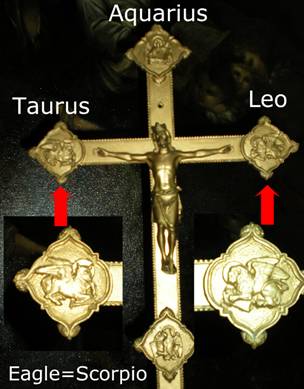
‘True Cross’ Cathedral Lisieux, France 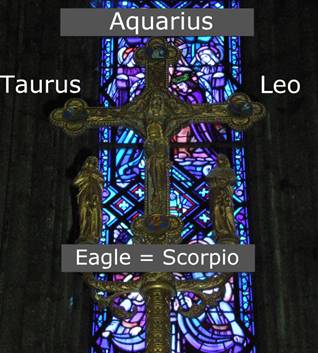
‘True Cross’, Baselique Notre Dame d’Ouvres La Delivrande, France
In churches, the four signs of the Zodiac often reoccur and are associated with ‘Judgment Day’ and the ‘End of Times’
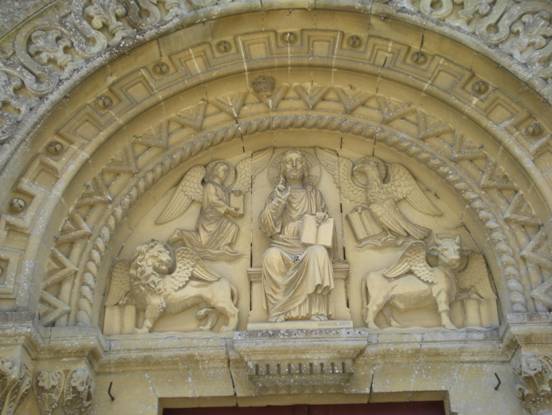
Jesus portrayed at the Last Judgment can often be found in the Tympanium above the entrance of churches and cathedrals. Notice, the lion (Leo) on the left, the bull on the right (Taurus), the angel on the left (Aquarius) and the eagle on the right ( Scorpio).
The four evangelists Luke, John, Mathew and Mark likewise have been associated with these four Zodiac signs as well:
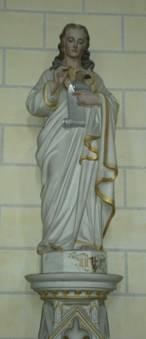 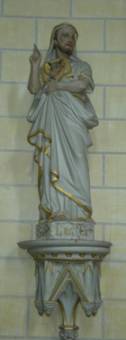 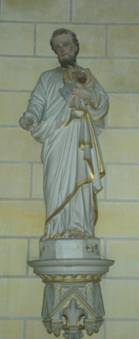 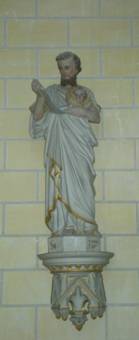
Mark = Scropio (Eagle), Luke = Taurus, John = Leo, Matthew = Aquarius
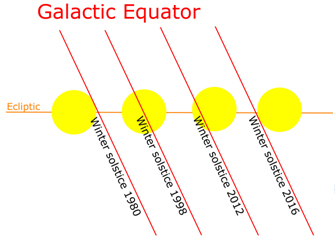 |
|
Winter Solstice Galactic Alignment of the Sun with the Galactic Equator
|
On Earth, the River Nile was the reflection of this great river in the sky, in accordance with the Hermetic principle "as above, so below." Herschel's earliest ingenious research has demonstrated that all of the pyramids along the river Nile represent constellations along the Milky Way, not just Orion! There are more than 50 pyramids in total, and their true meaning can only be deciphered when one considers the whole of Egypt.
During a Great Celestial Conjunction, the Sun crosses that great river in the sky, the Milky Way. Egyptologists explain that the solar God Ra (and Horus) required a boat because they sailed the Heavens from sunrise in the East to sunset in the West. At night, Ra travelled the Netherworld to be reborn in the morning at sunrise. Egyptologists reject the idea that the Egyptians understood the Precession of the Equinoxes and that the Sun also sojourns along the zodiac in a 26,000 year journey corresponding with the Precession Cycle.
In the Book of the Gates, the travel of the Sun at night along with the deceased pharaoh into the Netherworld is described. The Sun enters the Netherworld in the first hour just after sunset to be reborn in the morning at sunrise after a twelve hour nocturnal journey. There are many parallels, however, with the precessional journey of the Sun along the twelve signs of the zodiac to be discovered in the Book of the Gates. The 12 hours in the Book of Gates are structured into four groups of three hours, denoting a cross in the face of the clock. In the 12th hour Nun raises the solar barque with the scarab beetle of the Sun God from the primeval waters (Milky Way?), this is the hour of the rebirth of the Sun.
|
|
Left: Nun raises the solar barque from the primeval waters at ‘sunrise’, the time of the rebirth of the Sun.
|
During Ra's travel through all of the twelve signs of the zodiac in the precession cycle, he will be requiring a boat to twice cross that great river in the sky, the Milky Way! It is probably the only reason why the Egyptian deities required a Sun barque in the first place. Boats are used to cross waters, not skies, so it was used not for their nightly ecliptic travel from East to West through the Netherworld, but for their travels along the zodiac in the precession cycle. It is during this journey that the Sun would be required to cross the waters of the Milky Way at least twice. The Book of the Gates may therefore have been misinterpreted by Egyptologists as the nocturnal journey of the Sun simply because they reject the idea that the Egyptians understood Precession! Keep in mind that only twice per year on the equinox the day and night will be exactly 12 hours in length. It is therefore far more logical that the 12 hours in the Book of the Gates are in fact the 12 zodiacal Ages of the Precession Cycle.
Pharaohs in ancient Egypt were buried with their arms crossed holding Ankhs in their hands. This posture of the deceased pharaoh can be found on sarcophagus and in statues throughout Egypt. The Ankh represents a cross symbol.
|
|
Left: Grave statue of Tjel mayor of Memphis under Amenhotep III Dutch national museum of antiquities, Leiden.
Right: Sarcophagus with crossed arms and X cross on chest, Dutch National Museum of antiquities, Leiden.
|
Since the Greek inherited much of their wisdom from the Egyptians, it's more than reasonable to suspect that the gate or portal mentioned in the Book of the Gates through which the pharaoh enters the Netherworld is, in fact, the Gate of God that the Greek writer Macrobius writes about. The Gate of God was also called the Golden Gate, while the Gate of Men was called the Silver Gate. The very same Egyptian cross symbolism used by the pharaohs associated with the Golden and Silver gates of the soul (and the Sun) can still be recognized in the coat of arms of the Vatican, consisting of two crossed keys; one Golden, one Silver.
|
|
Silver and Golden cross in the Coat of Arms of the Vatican
|
The Golden Gate is the ecliptic Milky Way crossing at the Scorpio-Sagittarius nexus on the zodiac while the Silver Gate is the Milky Way ecliptic crossing at the Gemini-Taurus nexus. The Silver Gate was represented by the horns of Isis and the associated bull Taurus.
The Silver Gate is also clearly depicted in the Narmer Palette (3100 BC) named after the Egyptian pharaoh. The Narmer Palette shows the celestial goddess bull Bat (Taurus) with her horns bent over pointing exactly to the place of the rebirth of the Sun, the Silver Gate. The two cow's heads on top of the palette also represent Bat. In-between the two cow goddesses a hieroglyph is depicted representing the rising of the Sun in between two mountains on the horizon. It's a hieroglyph that is very similar to the Akhet hieroglyph with the same significance.
|
|
Bat on the left and right with the 'Akhet' glyph in between.
Dutch national museum of antiquities, Leiden
|
Bat was the goddess of the Milky Way considered to be a pool of Bat's cow milk. Bat was also the goddess of the human soul, the "Ba" that incarnated into human life form. Since the soul incarnated into human life passing through the Silver Gate (crossing of Milky Way and ecliptic), it's not surprising that Bat was both the goddess of the Milky Way and the human soul. Ba is a derivative of Bat, whereas "Ka" represents the human light-body. "Mer" represents the light of the Egyptian light-body-soul complex, the "Mer-Ka-Ba." Bat was also called the "Ba of Two Faces." Egyptologists are in the dark about her name and don't seem to understand that she was called this way, because there are actually two portals both to and from the Netherworld for the Ba to descend into the physical plane (Silver Gate) and ascend from the physical plane (Golden Gate). Both Hathor, Isis and Bat are all cow goddesses and Egyptologists have often pointed out the similarities between these goddesses depicted with cow-horns suspecting that they may have the same origins...they all represent the Silver Gate.
At the bottom of the Narmar palette in-between the horns of the bull, the very same hieroglyph is depicted as the one shown between two Bat bulls on top of the palette. This Akhet-like hieroglyph symbolises the rising Sun on the horizon.
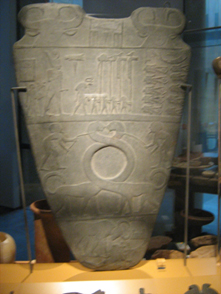 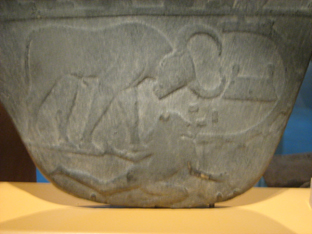 |
The Narmar Palette, bull in close up on the right. The bull is leaning towards the Silver Gate near the Gemini-Taurus nexus depicted in between the horns. The hieroglyph in between the horns resembles an Akhet glyph and represents the Silver Gate.
Dutch national museum of antiquities, Leiden
|
On the other side of the Narmer palette two identical men, hence suggesting twins are depicted. They are both looking over their shoulders to a particular square over the left man’s shoulder. We surmise that the twins represent Gemini which would make sense since the actual ecliptic Milky Way crossing of the Silver Gate occurs in 5° Gemini (sidereal zodiac) and the square could therefore be suggesting the Silver Gate.
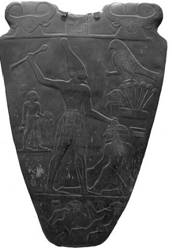 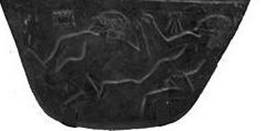
Narmer palette backside
Dutch national museum of antiquities, Leiden
The author Audrey of the website "Ancient Egypt" writes while referring to the Narmar Palette: "They present an overview of the astronomical event which occurred on September 21st in 4468BCE, when the Autumn (Fall) Equinox of the Sun was in conjunction with the Milky Way."
At the Autumnal Equinox, the Sun was indeed at the Milky Way, however at the Golden Gate. At the Vernal Equinox of 4468 BC, the Sun resided at the Silver Gate. The author (Audrey) does not seem to realise that this moment represented a Great Celestial Conjunction when the equinox axis (Vernal and Fall) aligned with the Galactic Equator and the Sun resided at the Gates of the Gods.
Instead, while interpreting the hieroglyphs of the 10 decapitated figures near the Solar Barque, he writes quote, "The full meaning of the hieroglyph can therefore be interpreted as 'the Sun at a sacred gateway, opening or portal'..."
While Hathor, Isis and Bat are all cow goddesses, Egyptologists have often pointed out the similarities between these goddesses depicted with cow-horns suspecting that they may have the same origins. . . .
We suggest that they all represent the Silver Gate.
There is an even older Egyptian goddess that later was associated with Isis and Hathor. Her name is Serket and she was the deification of the scorpion goddess who healed stings and bites. Eventually, Serket was associated with Isis and she was said to be just an aspect of Isis. Serket and Isis can therefore be regarded as the ‘Ba of Two Faces’. While Isis represents the Silver Gate at the Gemini-Taurus nexus, Serket is her counterpart and she represents the Golden Gate at the Scorpio-Sagittarius nexus. This is why she’s wearing the scorpion on her head while she joined Ra in his barque on his journey around the zodiac in a Great Year.
 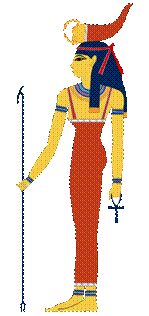
Left: Isis with the solar disk in between the horns representing the Silver Gate
Right: Serket with the scorpion at her head representing the Golden Gate.
The sacred Egyptian scarab beetle is a metaphor for the Sun in the precession cycle whereas the dung ball represents the Sun. The scarab beetle rolls its dung ball with his hind legs backwards, symbolizing the backward motion of the Sun through the zodiac in the precession cycle. Since the scarab beetle has many similarities with a scorpion, we surmise that Serket and the scarab beetle both represent the Golden Gate in Egyptian mythology.

Right: Scarab representing the crossing of the ecliptic and Milky Way
near Sagittarius-Scorpio nexus. The dung ball of Scarab beetle is the Sun.
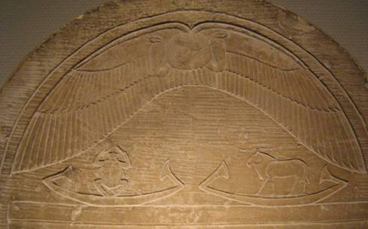
On the left, the scarab beetle in a barque. On the right, the bull with the horns in a barque. They represent the places where Ra requires a barque to cross the Milky Way river in the precession cycle and thus represents the galactic equator.
|
|
|
 Primer Primer
 Anterior
7 a 21 de 36
Siguiente Anterior
7 a 21 de 36
Siguiente Último
Último
|

